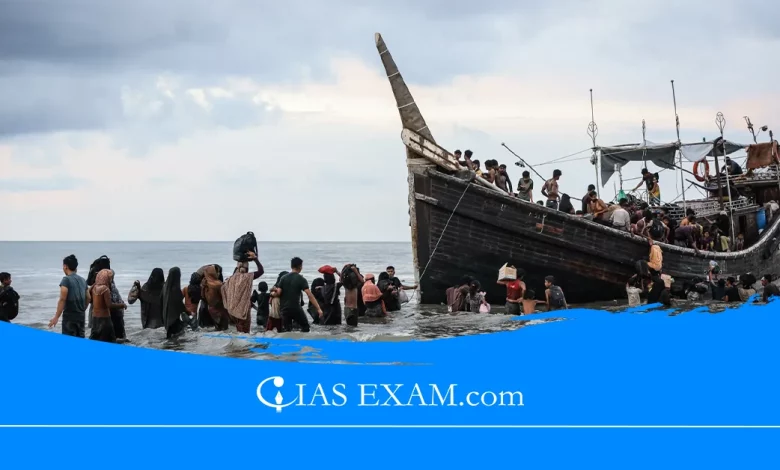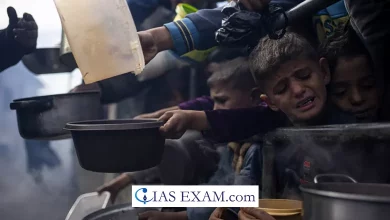Rohingya Refugees’ Maritime Peril
Syllabus: International Relations [GS Paper - 2]

Context
A few days ago, after the deck of a boat with refugees on board capsized off the coast of Indonesia, Rohingya women, children, and men struggling to stay afloat signified just how risky their escape is. This incident of over 140 people on board shows delicateness against the background of their life seeking a better world, and their from the sea journey risks. Now, global attention is drawn again to their life and the problem of their sea journey.
About Rohingya Refugee
- The Rohingya, who faced genocide in Myanmar, serve a simple fact they are useful for being the causal agents of the exodus.
- Reaching outbound borders of Bangladesh and sea trips that would turn into hazardous ones, they would at least try to be immune to trouble-mongering and, on the other hand, search for opportunities calling for international appeal of their humanitarian distress.
Their Concerns
- Yet, the Rohingya refugees face quite a bunch of problems, since the latter are heavily persecuted, gravely threatened with violence, and the state of play whereby they normally run the dangers of making them vulnerable to sailing through the sea which makes the journey dangerous, as well experiencing variations of unfair discriminations in terms of receiving education and healthcare opportunities.
- These migrants, when they are settled in the host country, are also prone to meet other challenges, such as the limited access to security human basic needs, which leads to an exposure that might be followed by resettlement and non-return; these migrants are hard to be resettled and often they do not go back home.
- The issue of migration in all senses should not be disregarded as it plays a globally significant role.
- Therefore, it is the prerogative of the world to pay attention and take action in order to move toward the overall wellbeing of the immigrants.
Reason for taking sea route and risking their lives
- The Rohingyas’s lives are mainly justified by the hopelessness in their hearts and the lack availability of any alternate routes.
- Fleeing persecution and violence in Myanmar, they face a stark choice: remaining in one spot just to survive or going for a span by candlelight or sea sailing.
- These routes are usually filled up with risks and dangers so that they can seem to become the options that would lead to nothing, but then they are ready to choose them, being the only way of getting security and wealth.
- Despite sea-crossing, however, poses grave threats including over-crowding , raging storms, and death by drowning and so forth, numerous Rohingya people declare their determination to embark on such perilous routes-the only available option and means for them to ensure their survival.
- In addition to that, they take advantage of the weakness of asylum seekers and offer them help to save them from imminent danger in exchange for too much money as a result of other dangers.
- Compassionate condition where the triggers are real torture and their existence as refugees is battered to the effects that they are running away from death is evident.
- This indicates that while there is division of work in the regional context between Myanmar and the neighbouring nations with regard to the protection and assistance, these countries are not fully capable of undertaking the burden.
- International involvement with the recognition of the triggers of displacement as well as diversification of ways for leaving should be of utmost importance for the decision making process of those vulnerable groups of people who perceive the world as a risky place and go seeking for safety.
Conclusion
- Eventually, the Rohingya refugee’s predicament on trial life is a reminder that the world needs to take speedy action and be united in their efforts. When they flee from persecution and torture in Myanmar, they result in facing various problems and being loom at the door of grave risks while still desirous of escaping and finding one’s better life.
- The international community must strive to address the fundamental factors that led to their displacement; provide refuge and recentralize their condign rehabilitation; and facilitate a way for them to settle in dignifying and secure locations. However, we believe deliverance of Rohingya refugees from their agony is not possible unless community involvement and compassionate intervention are the underlying factors that hold true the basic rights of Rohingya to protect their lives, humanise, and opportunities at large.
Source:The Hindu
UPSC Mains Practice Question
Q.Discuss the challenges faced by Rohingya refugees during their perilous sea journeys and analyse the implications for international humanitarian efforts. What measures can be taken to address their plight effectively? Provide recommendations with suitable justifications.





.png)



